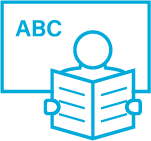Developing Productive Skills Through Receptive Skills – A Cognitive Approach
Communication plays an important role in every field of life. Language is used to communicate and express oneself to get ideas and to connect with persons. There are four basic skills of learning English language such as speaking, listening, reading and writing. Cognition refers to the mental activities like thinking, remembering, memory, learning, comprehension, perception, motivation and using language. Cognitive approach means the understanding and learning of information. Cognitive learning is about developing true understanding and is a way of learning that helps the learners to use their brains more effectively. The configuration of thought processes and psychological activities like problem solving and decision making from early childhood to adulthood is called as the cognitive development. This article deals with the ways and means of enhancing the speaking skills by intensive practice, writing through different activities and improving the receptive skills of the learners through cognitive approach.
Author: S. Sreena & M. Ilankumaran
Source: Sreena, S. & Ilankumarun, M. (2018). Developing productive skills through receptive skills – A cognitive approach. International Journal of Engineering & Technology, 7(4.36), 669-673. www.sciencepubco.com/index.php/IJET
• Language is a tool for communication and the way to interact with people to regulate their social behaviour.
• The transmission and interchange of ideas, facts, feelings or action is known as the process of communication.
• Language serves as the universal medium for conveying the common facts and feelings of everyday life.
• This paper concentrates on importance and barriers of the communication skills.
• The development of productive skills by the receptive skills is widely highlighted.
Communication
• Communication is derived from the Latin word “communicare” or “communico” which means “to share”.
• Communication is an exchange of words and meanings through ideas, facts, feelings and actions.
• Communication is a two-way process of sending and receiving messages. • Communication is done through words, actions, signs, objects or a combination of all these in a communication environment, such as classroom.
• A teacher makes use of activities that are specially designed to incorporate several language skills such as reading, writing, listening and speaking.
• Through daily activities, teachers provide learners with opportunities to develop each skill.
Significance of English language and language skills
• English is a unique language, and it is the only language that links the whole world together.
• Language skills are divided to productive skills and receptive skills.
• Productive skills are speaking and writing, and they may also be called as active skills.
• Learners who possess efficient productive skills are able to produce something. • Receptive skills are listening and reading, and they are used to extend knowledge and skills.
Cognitive approach to learning
• A cognitive approach to learning has been used to explain the mental activities and they are influenced both intrinsic and extrinsic factors, and the outcome is the learning of a person.
• Thinking is considered the most important cognitive skills of a learner. It is a mental process of considering or reasoning about something, and it helps to read, write and communicate effectively and very quickly.
• Critical thinking makes a person able to form opinions by looking at the facts behind an argument and also helps easily sort relevant information from the irrelevant. •Proper thinking exercises, such as argumentation with someone, help to improve the critical thinking of a person.
• Learning is an important cognitive skills.
• Learning to learn teaches a person how to develop and intimacy of learning and that will help a person to acquire new skills and quickly expand the knowledge of many subjects.
• Memory is one of the most important cognitive functions in a person’s activities, and it can be divided to verbal and visual memory according to the way the information is acquired to the memory, as well as to sensory memory, short term memory and long term memory according to how long the information has to be remembered.
• Remembering of learned things helps a lot to develop the communication skills of a learner.
• Cognitive perception is the way in which a person deals with information from the environment using senses.
• Perception is the process of absorbing things, organizing it in the brain and making sense of it.
• Reading is one of the most common examples of visual perception.
• Attention is also a cognitive process, and it avoids distractions in the environment in order to focus on what is important.
• Attention and perception are the cognitive processes of an expert in learning in the productive skills of communication.
• Motivation promotes an interest in the studies and directs behaviour towards particular goal.
Problem solving and decision making
• Problem solving is a cognitive process of human brain that investigates an immediate result for a given problem or finds a way to reach the ultimate goal.
• There are various steps to solve a problem while learning something.
• First, the learner needs to identify the problem; second, the learner must understand the nature of the problem; third, the learner needs to take different perspectives to understand the problem; fourth, the learner has to organize the available information and allocate resources; fifth, the learner needs to document the progress regularly; finally, the learner evaluates the result to find out if it is the best possible solution to the problem.
• The selection of a belief or a course of action among several different possibilities is considered as the decision making process.
Implications
• To improve the listening skills, students need attention and concentration. For these the teacher can give them task after conducting the class. An answer key may be given to them and ask them to correct their own answers and to record their own answers and then their own scores.
• If the learners develop their listening and reading skills through certain practice, they are sure to get a confidence to speak in any situation.



